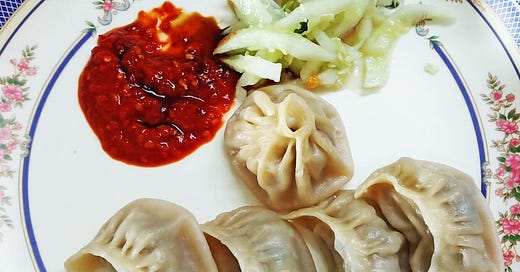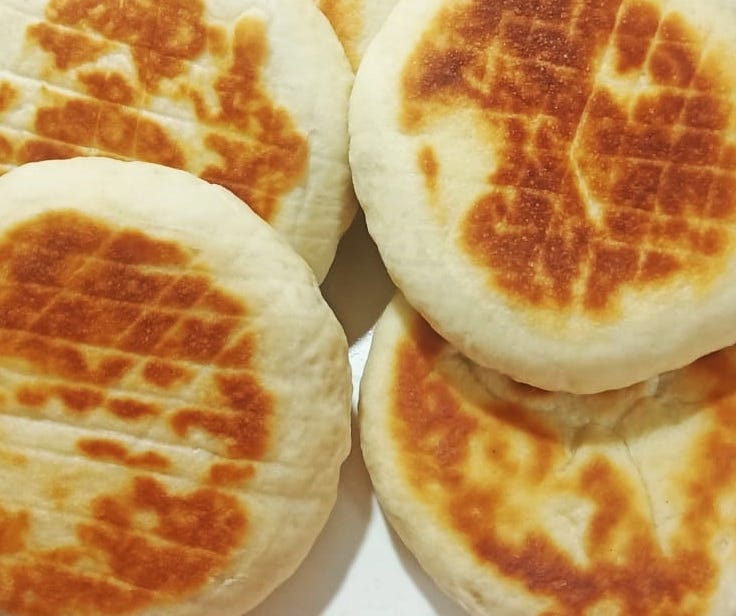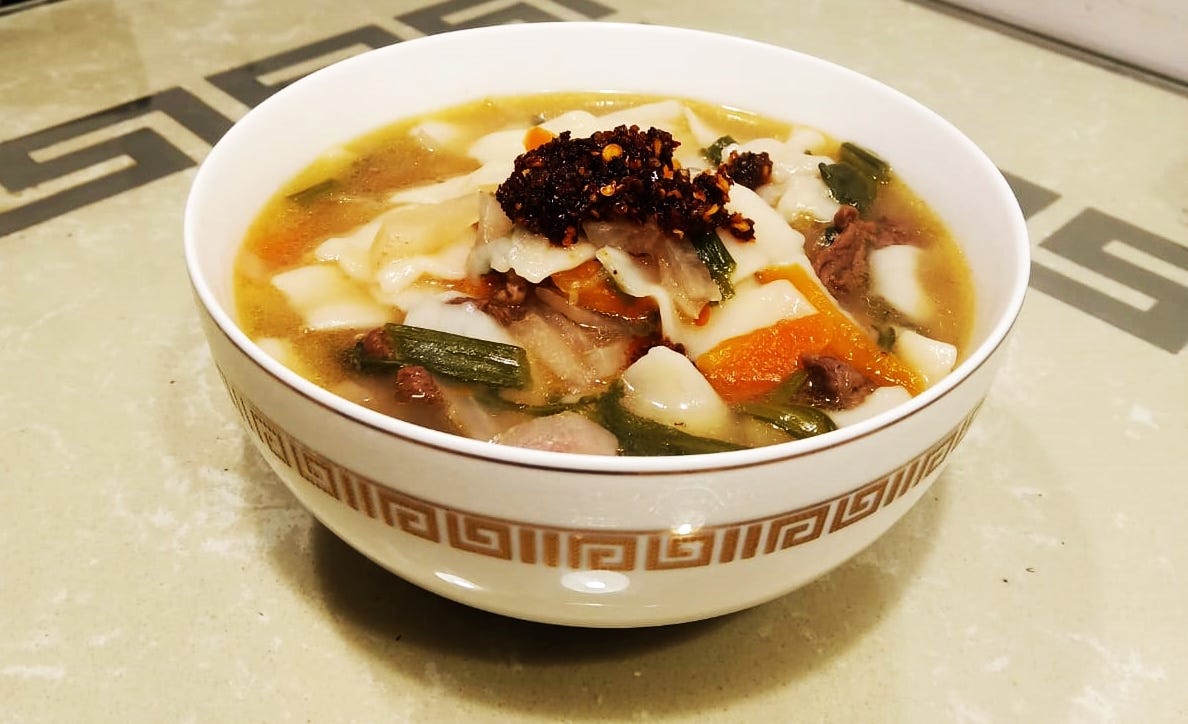Momos... Really?
When we encounter ‘Momo’ counters in Delhi and other metropolitan areas, do we really think of Tibetan cuisine? I’m not so sure.
The people behind the counters are often from Nepal or India’s North-east, and the ingredients have been adapted so much to suit urban tastes that if we were to serve an authentic momo, I fear customers might not even like it!
But that is the story of Tibetan cuisine. Even within Tibet, the situation is much the same. With the massive influx of Chinese migrants, Tibetans have become a minority in their own land, and so has Tibetan cuisine.
Tibetan Cuisine: A Short History
Tibet has historically maintained relationships with neighbouring countries such as Mongolia, China, Nepal, and India. These connections have influenced Tibetan culture, including its cuisine. However, due to Tibet's unique geographical location, harsh climate, and challenging terrain, the staple foods of Tibetans have remained largely unchanged for centuries—a fact that holds true even today.
Given the harsh weather and limited irrigation, agriculture in Tibet has always been a challenge, especially in areas where nomadic lifestyles prevail. Highland barley, or tsampa, emerged as the cornerstone of Tibetan cuisine. This resilient crop has been the bedrock of Tibetan sustenance, and it continues to be a unifying element across Tibet's three provinces.
The remarkable yak and dri (female yak) are also integral to the evolution of Tibetan cuisine. Due to the extreme weather, Tibetans are heavy consumers of meat and dairy products. Both the yak and dri play vital roles in Tibetan life; the dri's dairy products keep the women of the house busy from dawn till dusk. Incidentally, there is no such thing as 'yak butter'—the butter is always from the female yak! Men typically handle grazing and, when necessary, hunting. Deeply rooted in Buddhism, Tibetans do not kill animals for sport or excess; proper rituals and prayers are always observed, respecting the life taken.
Tsampa-eaters
Barley's importance is huge in Tibet. It is not only easy to grow but also widely accepted. Highland barley is unique and exclusive to Tibet—scientific research backs this up. Over the centuries, barley has not only become the staple food, but it has also found a significant place
in the religion and culture of Tibet. Barley and barley flours are used extensively on occasions such as the Tibetan New Year, Losar, Buddhist rituals, and even funeral ceremonies.
The highland barley grains are roasted and then ground under natural, flowing stream mills. The entire process involves a considerable amount of community work and feels almost like a neighbourhood festivity.
As my late mother used to say, for a nomadic family there is not a specific time for meals, so you can have Tsampa anytime, anywhere. The most common way of eating Tsampa is in Pa—usually made by mixing it with tea, butter, sugar, and dried cheese. The next step? Squeeze it into smaller pieces with your hand and pop it straight into your mouth. No utensils required!
Heavy Tea-drinkers
Another typical habit of many Tibetans is drinking Tibetan tea, or Bodcha. In popular culture, tea is prepared either as salted butter tea or black tea. Tibetans are happy to drink at least a few dozen cups from morning till late night!
For making salted butter tea, a special churner called Dongmo (a cylindrical length of wood about three to four feet in height) is used. This is to mix hot water, milk, butter, and salt. Every family must have one of these 'appliances'. My mother used to keep her collection of Dongmos in top condition by attending to them daily. However, surprisingly, by the time I was an adult, her tea-drinking habit had changed to sweet tea—with just a pinch of butter on the rim of the cup. Perhaps that is the perfect example of living in India while keeping your roots in Tibet.
Festivity and Occasions
Certain occasions in Tibetan culture call for specific foods that become especially popular. One such delight is Khabsay. Think of it as a Tibetan-style deep-fried snack made from wheat flour. There are several types of Khabsay in varied sizes and shapes, with Bungu Amchok (Donkey-Ear) being particularly notable. This shape is crafted during Tibetan New Year primarily for decoration and then, of course, devoured by the entire family with Bodcha. For a more detailed look at Khabsay, check out the interesting article by fellow Tibetan Jamyang Norbu la here.
Dresil is a lightly sweet rice dish with butter, sugar, raisins, and droma (a small, slightly sweet tuber) that graces special occasions like religious ceremonies and marriage feasts.
Bhartsa-Marku resembles a sweet Tibetan macaroni, made from wheat flour and cheese, and is served during the summer religious fasting practice of Nyungne. I still vividly remember my childhood in Manali. I would dash to Gompa, tossing my school bag aside, to join my mother and other community members for Nyungne and savour the delightful taste of Bhartsa-Marku. It is a dish that proves you do not need to fast from flavour!
Guthuk, a variety of Tibetan soupy noodles, is enjoyed two days before the Tibetan New Year. The unique feature of Guthuk is that it contains nine items, each one predicting the nature of whoever finds it in their bowl. It is like a culinary fortune cookie, but with more noodles and less crunch.
Stories from Exile
My earliest memories of childhood are from Manali in Himachal Pradesh, a state in India's north, where I was born. My parents were young exiles from Tibet during the 1960s. Over the years, my mother would often fondly recall how the locals of Manali, especially in Palchaan, welcomed them warmly. They offered local produce to the Tibetans, who were mainly road labourers contributing to the construction of the road from Manali to Leh. Tibetan dishes like Thenthuk, Shabakleb, Momo, Tingmo, Dropa-Khatsa, Gyuma, Lowa Khatsa, Shabtra, Bodcha, and Chang were enjoyed despite the tough living conditions. However, over time, many Tibetans began to adjust their eating habits.
A variety of vegetables and cereals were gradually introduced into their diets. Except for a few elderly Tibetans, our daily food consumption has become quite similar to that of other Indians. In this context, His Holiness the Dalai Lama often humorously proclaims that he is a ‘Son of India,’ since, for decades, many of us have been subsisting on Indian Daal and Roti. Nonetheless, on special occasions and in Tibetan areas across India, we still cherish our traditional Tibetan food, either at home or in small restaurants.
Popular Tibetan Food
Tsampa & Bodcha
As briefly mentioned earlier, Tsampa and Bodcha have become integral to Tibetan identity. This holds true in Tibet, but for Tibetans outside Tibet, while these two staples are cherished, they are not as frequently enjoyed daily. This may be due to environmental factors or influences from their immediate surroundings.
Dairy Products
Tibetans consume a lot of dairy products—from fresh dri (female yak), goat or cow cheeses, to yogurt, and even cheeses dried into rock-hard, bite-sized squares called Churra that you can suck on, much like a dairy jawbreaker.
Breads
Tibetans enjoy a variety of wheat breads rather than barley bread. Common breads include:
Baglep Korkun: Small, round flatbreads.
Amdo Baglep: Crusty, yeasted round loaves.
Tingmo: Steamed buns.
Numtrak Baglep: Deep-fried, puffy breads.
Momo
Momo are the most popular Tibetan food. They can be made with both vegetables (though the variety is limited) and meats, and can be fried, steamed, or served in soup. Despite their deliciousness, making momo requires skill and patience, as the process can be quite challenging and tedious. However, it is not too difficult to plan a ‘momo party,’ invite a few friends, and set up a production line!
Shabakleb
Shabakleb is a deep-fried bread stuffed with minced meat and vegetables, beloved just like momo. The labor-intensive process is quickly forgotten once this delightful bread is served with hot chili sauce.
A Bowl of Thukpa
Thukpa is a noodle soup famous for its warming effect, especially in the cold climate of Tibet. Typically made with meat, radish, and greens, the noodles range from long spaghetti shapes to little conch-like forms and flat 'pull' noodles of thenthuk. Traditionally handmade, modern methods have now been introduced. Some varieties of Thukpa include:
Dethuk: Includes yak or sheep soup stock with rice, several types of Tibetan cheeses, and droma (a small, slightly sweet tuber).
Gyathuk: Long spaghetti-type noodle soup.
Guthuk: Noodle soup eaten two days before Losar.
Thenthuk: Hand-pulled noodle soup.
Bhagthuk: Noodle soup with small handmade conch-shaped noodles.
Tsamthuk: Prepared with yak or sheep soup stock and tsampa (roasted barley flour) along with various Tibetan cheeses.
Meat
Contrary to widespread belief, Tibetans are not usually vegetarians; they are heavy meat eaters, primarily consuming yak and goat. The first-generation Tibetans in India during the 1960s and 70s had to adapt their diets, but in the cold climate of Tibet, meat has been vital for survival. Growing vegetables is challenging on the Tibetan plateau, so traditional diets (especially in Central Tibet) have focused on barley, dairy products, and meat, when available.
Yak Jerky: A favourite snack, often served with chunks of meat cut with knives and dipped in hot sauce—a common accompaniment for just about anything.
Shamdre: Meat with potatoes, rice, and crystal noodles.
Shabtra: Simple stir-fried meat dish.
Dropa Khatsa: Spicy stir-fried tripe.
Gyuma: Sausage filled with blood and minced meat.
Lowa Khatsa: Made from pieces of fried animal lung with spices.
Chang: Tibetan Beer
Chang is traditional and mostly homemade alcohol in Tibet, made from highland barley, millet, and rice grains. It is a popular drink during festivals and special occasions, such as weddings and religious ceremonies. Outside Tibet, Chang is often made with rice. In Tibetan social structure, Chang is also used to welcome guests and even to settle disputes, reflecting its cultural significance.
Few Recipes to Make Authentic Tibetan Food
Thenthuk or 'Pull' Noodle Soup
Soup:
• 1 kg meat with bone
• Ginger, onion, spring onion
• ¼ teaspoon Erma (Szechuan pepper), ¼ teaspoon whole pepper, salt
Dough:
• 3 cups wheat flour
• 1 egg
• 1½ – 2 cups water
Thenthuk:
• Vegetable oil
• ½ onion, chopped
• 3 cloves garlic, finely chopped
• ½ kg meat, sliced into thin bite-sized pieces
• 300 gm radish, sliced into thin bite-sized pieces
• Spring onion, for garnish
• Salt and soy sauce
Soup Base:
• Put all soup ingredients in a large pot, fill halfway with water, and bring to a boil. Once boiling, reduce heat and let simmer for about 45 minutes, skimming off any scum that forms. Add a little salt to flavour the meat but be cautious as the soup will become saltier later.
Dough:
• In a large bowl, place the flour and make a well in the centre. Add the egg and slowly incorporate water, kneading until the dough is firm but supple. Flatten the dough and cut into strips about one inch wide. Add a little oil, cover, and let sit on a plate.
Thenthuk:
• In a pan, heat a little oil and fry the radish on medium heat until golden. Set aside.
• In a large pot, heat oil, add onion and garlic, and cook until the onion is browned. Add the meat, black pepper, salt, and a dash of soy sauce. Once the meat is browned, add the strained soup stock and bring to a boil.
• Add the browned radish. Flatten and pull strips of dough, breaking off thumb-sized pieces and adding them directly to the soup. Avoid getting steam on your hands by staying clear of the pot. Alternatively, pull longer strips and add them. Once all the dough is added, cover, bring to a boil, and turn off the heat. Let stand for two minutes. Garnish with chopped spring onion.
Serve:
• Serve the boiled meat with a spicy hot sauce on the side. Follow with bowls of thenthuk and a side of vegetables.
Momo: Tibetan Dumpling
The Dough:
• 4 cups flour (wheat flour is healthier, refined flour is tastier)
• 1 to 1½ cups water
• In a large bowl, make a well in the centre of the flour. Gradually add water, mixing until the dough holds together. Knead until firm but supple. The more you knead, the better the dough.
The Filling:
• 1 kg minced meat
• ½ kg finely chopped onions
• 2 stalks finely chopped spring onion
• Small bunch finely chopped coriander leaves
• 1 tablespoon oil
• 2 tablespoons soy sauce
• ¼ cup water
• Salt and black pepper to taste
• A dash of Erma (optional)
• In a large bowl, combine the meat, chopped vegetables, and remaining ingredients. Mix thoroughly, preferably with your hands, to ensure the mixture is well combined. Adding a little water and greens makes the filling juicy.
Making the Dumplings:
• Divide the dough into four parts. Shape one portion into a long roll and pinch off small pieces. Roll each piece into a ball, then flatten into a 3”-3½” round circle—this is your momo skin.
• Place a spoonful of filling in the centre of each dough circle. Fold and seal the edges, trying not to overlap too much to avoid a thick layer of dough.
• Oil your steamer tray and arrange the momo close together but not touching. Add water to the steamer base and bring it to a boil before stacking the trays.
The Steaming:
• Steam momo for 12-15 minutes, adjusting for altitude and stove strength.
• To check if done, lift the lid and observe the steam. If dry, the momo are done; if wet, continue steaming. Touch a momo; if sticky, it needs more steaming. Alternatively, cut one open to check.
Bodcha: Tibetan Butter Tea
Ingredients:
• 3 cups water
• 1 teaspoon broken tea leaves (compressed tea)
• ½ cup milk
• ½ teaspoon salt
• 1 tablespoon unsalted butter
Recipe:
• Boil water, add tea leaves, and simmer for 10-15 minutes until the tea is a dark amber colour. Strain the tea, then add warm milk, salt, and butter. Churn using a blender.
• For a quicker method, brew a concentrated black tea, add hot water to the concentrate, then mix in milk, salt, and butter. Blend well to serve.I hope you enjoyed reading this piece. Tibetan cuisine is a beautiful blend of tradition, culture, and adaptability. From the comforting Thenthuk to the ever-popular Momo, each dish reflects a rich heritage and a deep connection to the land. Though the ingredients and methods may evolve with time and place, the essence of Tibetan food remains a cherished part of our identity. As you explore these recipes and perhaps share them with others, may you find a taste of the warmth and spirit of Tibet in every bite. However, while digital sources are plentiful, nothing beats the experience of tasting these delicacies with a Tibetan family. After all, you might find countless counters of Momo’s’ in your locality, but the 's' in those might just be a mystery!
To read the intent behind this post, click here.






